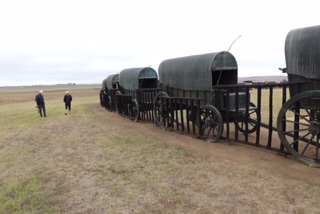Blood River

VulcanSpirit
Richard & Alison Brunstrom
Tue 8 Dec 2015 05:20
By 1837 the Dutch Voortrekkers (Pioneers) had entered what is now KZN and was then the Zulu Kingdom via the mountain passes from the Drakensbergs in the southwest in search of farm land (this migration was caused in part by the British purchase of the Cape Colony from the cash-strapped Dutch government-in-exile in 1814, a decision taken without consulting the Dutch settlers thus causing long lasting resentment). Initial peaceful negotiations broke down when the Zulu king killed Boer leader Piet Retief and about 500 followers at a feast in February 1838, accusing them of witchcraft. A revenge mission was mounted led by Andries Pretorius (hence Pretoria, the modern capital of SA) who proved to be a most able leader. Pretorius had about 500 Voortrekkers with him, heavily armed and with ample ammunition. He skilfully avoided terrain traps that the Zulus had been trying to lead him into, and instead carefully chose the ground on which to fight. On 16 December 1838 battle was joined at what is now known as Blood River. Pretorius formed a laager, a defensive circle of wagons, with gaps for the deployment of mounted troops, and defensive fencing panels on the outside. He was also lucky. A thick fog descended on the night before the battle, and the highly superstitious Zulus took the wagon lights dancing mysteriously in the mist on the end of poles to be evil spirits and a bad omen which lowered their morale and prevented a night attack which might have changed the outcome utterly. The Zulus had also recently changed their weaponry, favouring a short stabbing spear instead of their previous throwing spears; a bad choice when facing firearms.
In any event the battle was a massacre. The Zulus lost at least 1500 men, and possibly double that, against three minor injuries to the Voortrekkers. The power of the Zulu kingdom was broken and civil war broke out.
The Boers took this decisive a victory as a sign that God (they were and unpleasantly pious and self-righteous lot) had directly intervened on their side, and as proof that they had a divine right to an independent existence on land of their choosing - and thus leading to much grief and bloodshed right up to modern times. The battle site is revered as sacred ground by pious Afrikaners to this day and hosts an annual celebration of their victory - sadly marred even recently by the thuggish tactics of the racist right wing.
When the Voortrekkers reached the Zulu capital they found it burned down and abandoned as a consequence of the civil war. But they allegedly found, in a leather satchel next to the body of Piet Retief, the agreement signed by the Zulu king just before the murders granting the whole of the southern part of his kingdom to the Boers, and this became the indecent Boer Republic of Natal from 1838-43. Its boundary was vital to the subsequent British disaster at Isandlwana years later. The original of this document has conveniently disappeared but copies abound and are part of Afrikaner mythology - although many academics now think the whole thing is a forgery, possibly a contemporaneous one, to justify land theft from the Zulus.
Blood River now hosts a huge and impressive monument, divisively built and maintained by the Afrikaner community not the government. It is probably one of the biggest sculptures in the world. The entire laager of wagons has been recreated in steel covered by bronze, on its original site. Here it is:
A wagon removed from the line to allow mounted troops to sally:
A Zulu's view of the laager showing what a formidable obstacle against unarmed warriors Pretorius had designed:
And here is our party of eight historically minded but sadly ill-informed UK cruisers together with our guide Paul Garner (standing in the red shirt). Paul is a first rate local historian and raconteur, speaks English Afrikaans and Zulu, and seems to know every bird and beast in SA by its first name. We hired him for the whole of a long day to see the battle sites, and he added huge value to the visit. Very highly recommended if you're coming this way - see his website.
Note the small cannon; there were two, surprisingly both ex-RN. And note the weather; this is summer, but it's misty, windy and seriously cold - your correspondent is sheltering from the wind behind the wagon in the foreground, badly under-dressed.
Sent from my iPad



